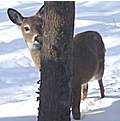- By Dan Veaner
- News
 Print
Print  The Village of Lansing Trustees have authorized up to $6,000 for supplies and bait for a new twist on their deer population management program. At their last Board of Trustees meeting Cornell University Department of Natural Resources' Dr. Bernd Blossey presented a proposal that will dramatically change the way deer are taken, which he says he hopes will make the program more effective and more efficient in reducing the Village deer population to sustainable levels. The idea is to forego the regular hunting season in favor of a focused nuisance season that allows baiting the deer and night hunting.
The Village of Lansing Trustees have authorized up to $6,000 for supplies and bait for a new twist on their deer population management program. At their last Board of Trustees meeting Cornell University Department of Natural Resources' Dr. Bernd Blossey presented a proposal that will dramatically change the way deer are taken, which he says he hopes will make the program more effective and more efficient in reducing the Village deer population to sustainable levels. The idea is to forego the regular hunting season in favor of a focused nuisance season that allows baiting the deer and night hunting."This year we're seriously considering enlarging that nuisance take," said Mayor Donald Hartill. "It would be under the same rules that we've had in the past in terms of everybody involved has to agree to it. It would be in the same locations we've had in the past, perhaps with the addition of a few more Cornell properties. My personal opinion is that this is a path forward that we can use to maintain a reasonable deer population without going to extreme measures."
Blossey says he is less interested in the number of deer in the Village than he is in reducing the population where ecological damage has been devastating, as deer eat away all new forest growth and private gardens. He said a similar program in the Village of Trumansburg and on Cornell properties has been extremely successful.
"It is so much more efficient in terms of the time investment of individual participants," Blossey said. "Instead of investing ten or eleven hours per deer taken we know we can reduce that to two or three hours. We're trying to increase the area where we have a 'nuisance program exclusively' zone because typical recreational hunting during hunting season doesn't give us what we need in terms of deer reduction."
The Village program was established eight years ago, restricting Village-vetted bow hunters to lands that were adequately large that landowners agreed to allow hunting on, as well as agreement of adjacent neighbors on whose property it might be necessary to capture wounded deer. The program was held during the conventional bow hunting season as determined by the New York State Department of Environmental Conservation (DEC).
"Over the years the yield of deer decreased," said Hartill. "In the beginning we used to take 40 or so deer by bow and 40 or so deer by car. That then went up to a peak of around 60 by bow, and by car it went down to 20 or so. The 'by car' take has remained at around 20 or so. The population, on the other hand, has increased slightly. Last year we instituted a nuisant hunt in late January and part of February. That doubles our take by bow, getting us back up to where we should be in terms of maintaining an equilibrium population.
If approved by the DEC, the program will begin at the beginning of October and run through the end of March. Only approved hunters will be allowed to participate, and each participant will be assigned a specific strategic location. Automatic feeders will be used to attract deer, and Blossey says there will be gaps in the times when deer are hunted so they do not get used to areas being dangerous from hunters. Hunters will be responsible for accounting for every arrow that is shot. Any meat the hunters can't use will be processed and donated to the Food Bank of the Southern Tier.
Blossey said that some hunters will provide their own automatic feeders, but he asked the Village to finance the purchase of around 10 feeders and corn to bait them with. He estimated that each feeder costs about $120. He noted that arrows cost between $15 and $20. Another potential expense would be an overflight during the winter in which the deer population is assessed using infrared photography.
Hartill was concerned that Village law, which does not allow any firearms, but makes an exception for approved hunters in the Village program to use bows and arrows, would need to be amended to account for the special season. But Village Attorney David Dubow said the law refers to DEC approved hunting seasons, and that a nuisance season will be covered by the current wording of the law.
"We determined last year that we did not have to do that," Dubow said. "With the nuisance season we determined that the language is consistent and acceptable because it reflects just the broad provision with respect to a DEC deer management program."
Deputy Mayor Gerry Monaghan proffered a motion to support the deer population management program for the 2015-16 season, and expend up to $6,000 for supplies and a population assessment. It was passed unanimously.
v11i38



